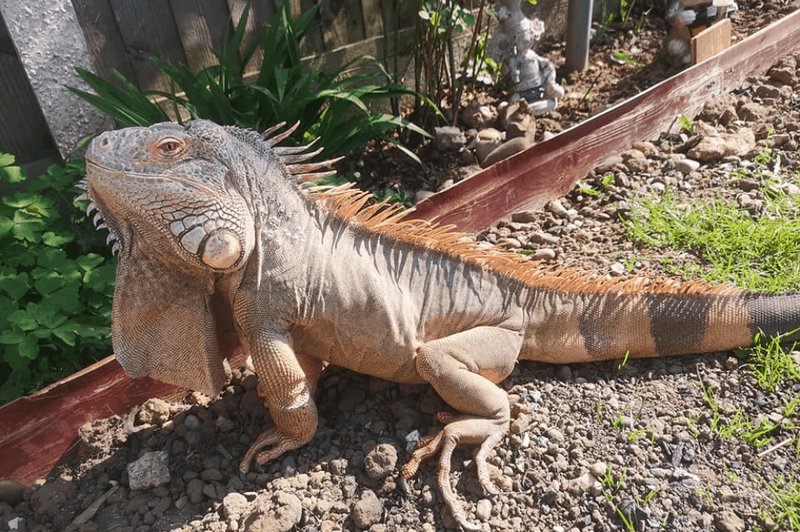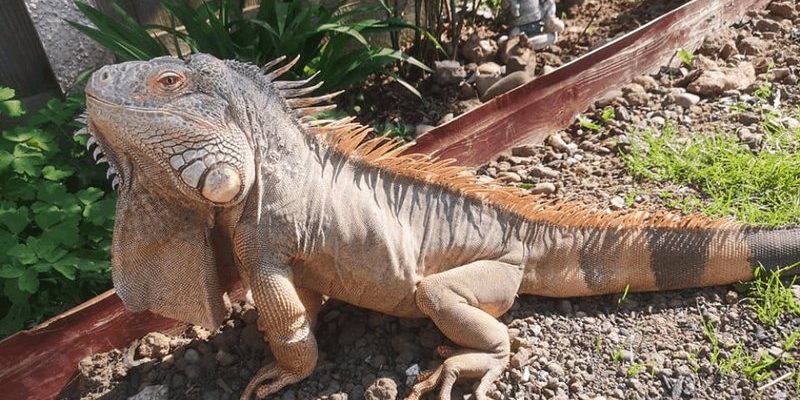
Now, taming your iguana isn’t about forcing it into submission. It’s more about building trust. Think of it as nurturing a delicate plant. You wouldn’t just dump water on it and expect it to flourish; you’d learn about its needs, create the right environment, and then watch it thrive. In this guide, we’ll tackle the steps you can take to help your iguana feel safe and secure, thus reducing its aggression. Let’s dive in!
Understanding Iguana Behavior
Before you can start the taming process, it’s important to understand why your iguana behaves aggressively. Iguanas are naturally wary creatures. In the wild, they face various threats, and that instinct to defend themselves carries over into captivity. When feeling threatened, they might puff up, hiss, or even bite as a defensive mechanism.
Here’s the thing: learning to read your iguana’s body language can be a game-changer. Pay attention to their posture. If it’s standing tall with a puffed-up throat, it’s a sign of aggression. Conversely, a relaxed iguana might lay flat with a slight tail sway, indicating it’s calm. This understanding helps you respond appropriately, reducing the chances of a confrontation.
Additionally, it’s about patience. Just like how some people take longer to warm up, iguanas also need their time. Establishing a connection requires respect for their space and their mood. Remember, your iguana is a little creature with a vast world to explore, and it needs to feel safe while doing so.
Creating a Comfortable Environment
An iguana’s environment plays a huge role in its behavior. If your iguana feels stressed or unsafe in its habitat, aggression is almost a given. Start by ensuring your iguana’s space is enriched and inviting. A large cage with plenty of hiding spots, climbing branches, and basking areas can make a big difference.
Consider placing items like logs, rocks, or artificial plants inside the enclosure. These elements create a more natural atmosphere and give your iguana places to explore and hide. Additionally, ensure proper temperature gradients—like warm basking areas and cooler shady spots—so your iguana can regulate its body temperature comfortably.
Let’s not forget the importance of cleanliness! Regularly clean its cage to prevent unpleasant odors and bacteria build-up. A clean space can contribute to a happy iguana, reducing stress levels and, in turn, aggressive behavior.
Building Trust Gradually
Now that the environment is set, it’s time to build trust. Here’s where the magic happens. Start with short, positive interactions. Approach your iguana slowly, allowing it to see and smell your presence. When you first introduce your hand, try placing it in the enclosure but keep your fingers still, like how you’d introduce a new friend to a skittish dog.
Next, consider offering treats. Fresh vegetables or fruits can be a good start—things iguanas love. Let your iguana come to you for the treats rather than forcing it into your hand. Positive reinforcement is key here! Over time, your iguana will associate your presence with fun and tasty snacks.
After a few days of gentle interaction, you can begin to touch your iguana gently. Aim for the back or sides, where it feels less vulnerable. Always be mindful of its reactions. If it seems agitated, back off. The goal is to make these moments enjoyable, helping it relax around you.
Essential Handling Techniques
When it comes to handling your iguana, the right technique can make a world of difference. First off, avoid grabbing your iguana suddenly. Instead, allow it to approach you, or gently scoop it up with both hands. Support its body—this not only makes it feel secure but also shows that you’re not a threat.
One effective way to handle your iguana is to place it on your chest or lap, allowing it to feel your warmth and heartbeat. This can be soothing for the iguana. While doing this, make sure to stay calm and avoid sudden movements. Think of it as a cozy catch-up session with a friend; you want it to be relaxed and comfortable, not tense and jumpy.
Also, be mindful of the time. Iguanas can get overstimulated, so short handling sessions—around 10 to 15 minutes—are ideal, especially in the beginning. As trust builds, you can gradually increase the duration. Always end on a positive note, even if it means putting your iguana back before it shows signs of stress.
Recognizing Signs of Stress
Being aware of stress signals is crucial when it comes to taming your iguana. If you notice your iguana hissing, puffing up, or attempting to bite, it’s sending a clear message that it feels threatened. Understanding these signs can help prevent aggression from escalating.
Another sign of stress is if your iguana begins to whip its tail or tries to escape its enclosure. When you see these behaviors, it’s best to give your pet some space. Remove your hands from its territory and allow it the time to calm down. You might be wondering why this is important. If you dismiss these signals, it can lead to further aggression or anxiety for your iguana.
Creating a calming routine can also help minimize stress. Having a consistent daily schedule for feeding, cleaning, and interaction can provide predictability. Predictability helps your iguana feel secure, reducing anxiety.
Consistency is Key
The journey to tame an aggressive iguana isn’t an overnight process. It requires consistency and patience. Daily interactions, even if they’re brief, can significantly improve trust. It’s about showing up for your iguana, much like you would for a friend who needs a little reassurance.
Establish a routine for feeding and handling. Keep track of your iguana’s behavior to identify what works and what doesn’t. If it seems more relaxed on certain days, take note of those factors—perhaps it was a sunny day or you played calming music.
Also, don’t forget to document your iguana’s progress. Jot down any changes in its behavior or mood. This not only provides insight but also helps you celebrate the little wins along the way.
Consulting a Professional
Sometimes, no matter how much effort you invest, you might find yourself stuck. If your iguana’s aggression doesn’t seem to improve, or you feel unsure about handling it, consulting a veterinarian or a reptile behaviorist can provide valuable insights. They can assess your iguana’s health and well-being to rule out any underlying issues contributing to the aggression.
Additionally, professional trainers can equip you with techniques tailored to your iguana’s specific needs. It’s okay to seek help—just like we do with our pets; after all, your goal is to ensure a happy, healthy relationship.
Ultimately, working with professionals can create a supportive network for you and your iguana. Just as you would seek guidance on a tough project, getting expert help can make a significant difference in your journey to tame an aggressive iguana.
In conclusion, taming an aggressive iguana takes time, effort, and a lot of love. By understanding their behavior, creating a safe environment, and gradually building trust, you’ll pave the way for a more cozy relationship. Remember, patience is your best friend in this journey. With enough time and attention, you’ll see your iguana transform from a feisty little creature into a gentle companion. So, take a deep breath, enjoy the process, and watch the magic unfold!

